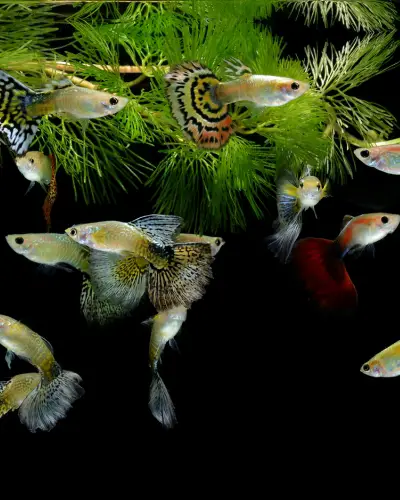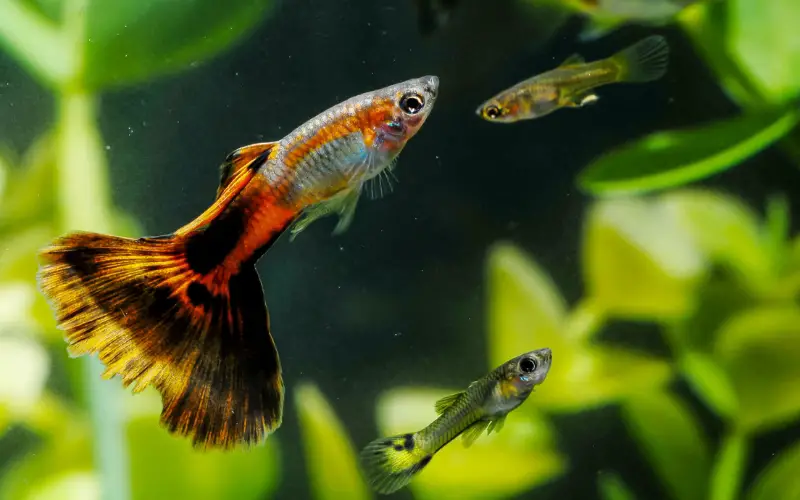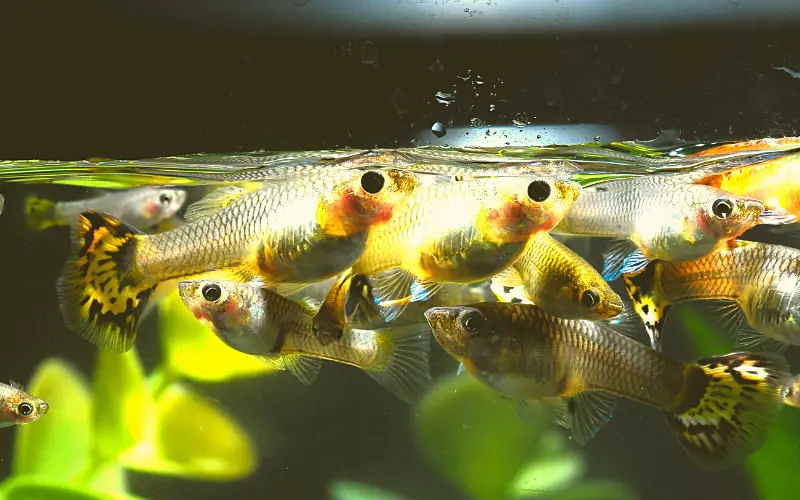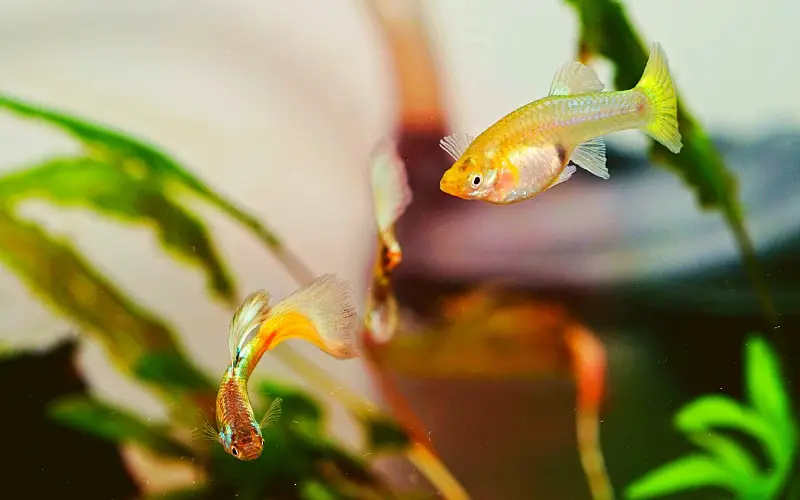Will different types of guppies school together? For aquarium hobbyists, the idea of guppies schooling together is a fascinating prospect. These small and vibrant fish are beautiful to behold, but their complex social behaviors have much to teach us about group dynamics in nature.
So what happens when you mix different types of guppies in one tank? Can diverse species schools as if they were one cohesive unite?
Do different guppies get along? Keeping different types of guppies in the same aquarium can feel like a daunting task.
Without knowing how they will interact with one another, you could experience an unexpected disaster.

Even if all the guppies look compatible to you, it’s difficult to know if they will co-exist without engaging in negative behavior. If this happens, your aquarium can quickly become a chaotic environment.
In this blog post, we’ll look at the potential outcomes of mixing up these popular freshwater fish and provide some tips on creating a harmonious home for them all.
Keep reading; this resource helps you choose the best match for your tank so everyone can thrive!
Table of Contents
ToggleWill Different Types of Guppies School Together?
Can different types of guppies live together? You can safely add various species and colors of guppies to your aquarium and trust that they will get along harmoniously. Guppies are social fish, and they flourish in a tank with multiple individuals of their kind.

You can fill your aquarium with guppies from different species and colors without much risk of conflict or aggression.
Can You Mix Guppies Together?
Can I keep different types of guppies together? The short answer is yes—you can keep different types of guppies in the same tank. However, it’s important to remember that even though they look compatible and seem like they’ll get along fine, there are still potential risks.
Guppies have been known to fight or display aggressive behaviors when mixed with different species. This is especially true if they’re the same gender, as male guppies may become territorial and compete for dominance.
It’s best to keep different types of guppies in separate tanks or groups. To avoid any potential problems,
There are a few things to consider when mixing different species of guppies in the same tank. Ensure you’re using an appropriate-sized tank for the guppies you plan to keep. You want to keep your tank manageable, as that can lead to stress and health problems.
Types of Guppies
There are several different types of guppies you can choose from. Some of the most popular varieties of guppies include:
- Standard Guppies: These are the typical guppies found in pet stores and come in various colors and patterns. They’re relatively easy to care for, active swimmers, and make great fish for beginners.
- Endler Guppies: These are a type of wild guppy fish that originate from South America and come in unique colors and patterns. They’re slightly more delicate than the standard guppy and require more experienced care.
- Fancy Guppy: These are a hybrid between two guppy species, resulting in a more colorful and exotic-looking fish. They’re usually larger than other varieties but require the same care as any other guppies species.
Guppies are great aquarium fish and make wonderful additions to any tank. With the right care and environment, they can be healthy, active swimmers that will bring a lot of joy to their owners. So, if you’re looking for an easy-to-care-for fish for your tank, guppies are a great choice!
How Many Guppies Should Be Kept Together?
A good rule of thumb for keeping guppies together is two or three female guppies for every male. This ensures that all the fish are happy, have enough space and food, and can explore their natural behaviors without overcrowding.
It also helps reduce aggression between males as they compete for mate selection. Remember to keep at least five guppies per 20 gallons of water to ensure proper filtration and oxygenation.
Therefore if you have a 20-gallon tank, it would be ideal to include 6-9 guppies (2-3 males with 4-6 females). Experts can house ten to fifteen guppies in the same space comfortably.
Will Fancy Guppies Breed with Feeder Guppies?
Yes, Fancy Guppies and Feeder Guppies can breed with each other without any repercussions. Breeding Fancy and Feeder Guppies is considered one of the most popular techniques for creating better-looking fish.
Breeding Fancy and feeder Guppies allows you to obtain certain desirable traits such as brighter colors, bigger sizes, or even more interesting patterns from their offspring.
It should be noted that some individual Fish may carry genetic issues due to their lineage; however, this can easily be avoided by only using healthy fish for breeding guppies’ purposes.
How Many Guppies in a School?
How many guppies should be in a school? The best way to set up a successful guppy school is by having five to eight guppies of the same species. Each fish must have enough space and clean, oxygen-rich water to ensure they remain healthy.

Guppies can create their social structure by having an adequate number of fish in the fish tank, promoting better health and happiness. It also allows them to explore and guppies swimming freely, providing more stimulation and entertainment.
Keeping guppies in a school benefits the fish and their owners. They provide an interesting spectacle to observe, but keeping them in groups can help reduce stress levels, making them less susceptible to disease or illness.
Can You Mix Male and Female Guppies?
Can I keep male and female guppies together? Male guppies can be quite aggressive in pursuing females, particularly if the females are scarce compared to the number of males. Like males of other guppy species, males can get feisty in their attempts to attract a mate.

When this happens, physical confrontations may occur, and the female guppies can become stressed or injured. Therefore, keeping only one male with several females is best to reduce the likelihood of physical attacks and stress.
Keeping them in separate tanks or having a divider between the two sexes is recommended if you want to keep both males and females. This will help reduce the chances of aggression, stress, and injury among the guppies.
How Many Female Guppies Should Be Kept Together?
The ideal number of female guppies together depends on the tank size. Generally, it is best to keep four or more females in a 10-gallon tank so that they have room to swim and explore without feeling threatened.
Additionally, adding two males can help reduce stress among the females. Keeping only two female guppies together can create competition for food and territory, making them more aggressive with each other.
Can You Keep Different Types of Male Guppies Together?
It is not recommended to keep different types of male guppies together. Males are territorial and will fight amongst themselves over territory, leading to injury or death.
Furthermore, multiple males in one tank can increase stress levels for all fish. It is best to keep only one type of male guppy per tank if you want them to thrive.
Commonly Asked Questions About Are Guppies Schooling Fish (FAQ)
Can I Keep 3 Male Guppies Together?
No, keeping more than one male guppy in the same tank is not recommended. Male guppy fish is territorial and may fight over territory, which can lead to injury or death. It is best to keep one type of male guppy per tank if you want them to thrive.
What’s the Difference Between Schooling and Shoaling Fish?
Schooling fish tend to form large groups and swim together coordinately. Shoaling fish, on the other hand, are more loosely organized and move in smaller groups or alone. They also do not swim together coordinated like schooling fish do.
Can You Breed Different Types of Guppy?
Yes, you can breed different types of guppies. This is called hybridization, and it can lead to some interesting results. However, this can also be risky, as hybridization can lead to health issues and weaker offspring.
Have You Ever Wondered How a Female Guppy Seems Endlessly Pregnant?
Female guppy fish can reproduce asexually and retain sperm for multiple spawning cycles. This means a female guppy can keep sperm from a mate and use it to fertilize her eggs multiple times. This is why . It is best to keep one type of male guppy per!
Can You Mix Guppies with Other Fish?
Yes, you can mix certain guppies with other types of fish like neon tetras, Cory catfish, Zebra danio, and Swordtails. However, it is important to research the compatibility of the fish species you plan to mix with guppies before introducing them into the same species tank.
Can I Keep Two Female Guppies Together?
Yes, two females can be kept in the same tank. Ensuring you have enough hiding places and food for both is important. Adding some males to the tank is also a good idea so that the female fish are not competing for attention and resources.
How Many Guppies Should Be in a 10-Gallon Tank?
A 10-gallon tank should support up to 5-7 guppies. However, it is important to remember that guppies are social creatures and should be kept in groups of at least five to keep them happy and healthy.
Can I Keep 2 Male Guppies Together?
Two male guppies can be kept together, but ensuring enough hiding places and food for both is important. Male guppies can become territorial and fight each other, so keeping guppies in an appropriately sized tank with plenty of vegetation for hiding spots is best.
Conclusion
So, can different types of guppies live together? Research has shown that guppies of different sizes and colors can school together in an aquarium. While signals from the aquarium environment can affect whether the schooling behavior is observed, it can also depend on the type of guppies present. Nonetheless, when these fish share the same space, they will work together to form a cohesive group that can bring biodiversity to any aquarium.
Different types of guppies will school with a certain level of success; however, some factors, such as water temperature and food availability, can impact their ability to do so. Aquarists need to be mindful of these details to create a healthy environment and allow the fish to live harmoniously together. By ensuring that all essential needs are being met and monitoring behaviors regularly, we can ensure that these unique creatures cohabitate easily.
You might also like
- How Many Guppies in a 10 Gallon Tank: (An Exclusive Guide)
- How Often Do Guppies Have Babies? (A Comprehensive Guide)
- How Often Do You Feed Guppies: 9 Tips to Keep Guppy Healthy
- Will Different Types of Guppies Breed? (An Exclusive Guide)
- How Many Babies Do Guppies Have? (Let’s Quell The Myth!)
- Does Guppies Eat the Fry: (5 Reasons & Solutions)
- Endler Hybrid Guppy: 5 Mind-Blowing Facts You Need to Know!





